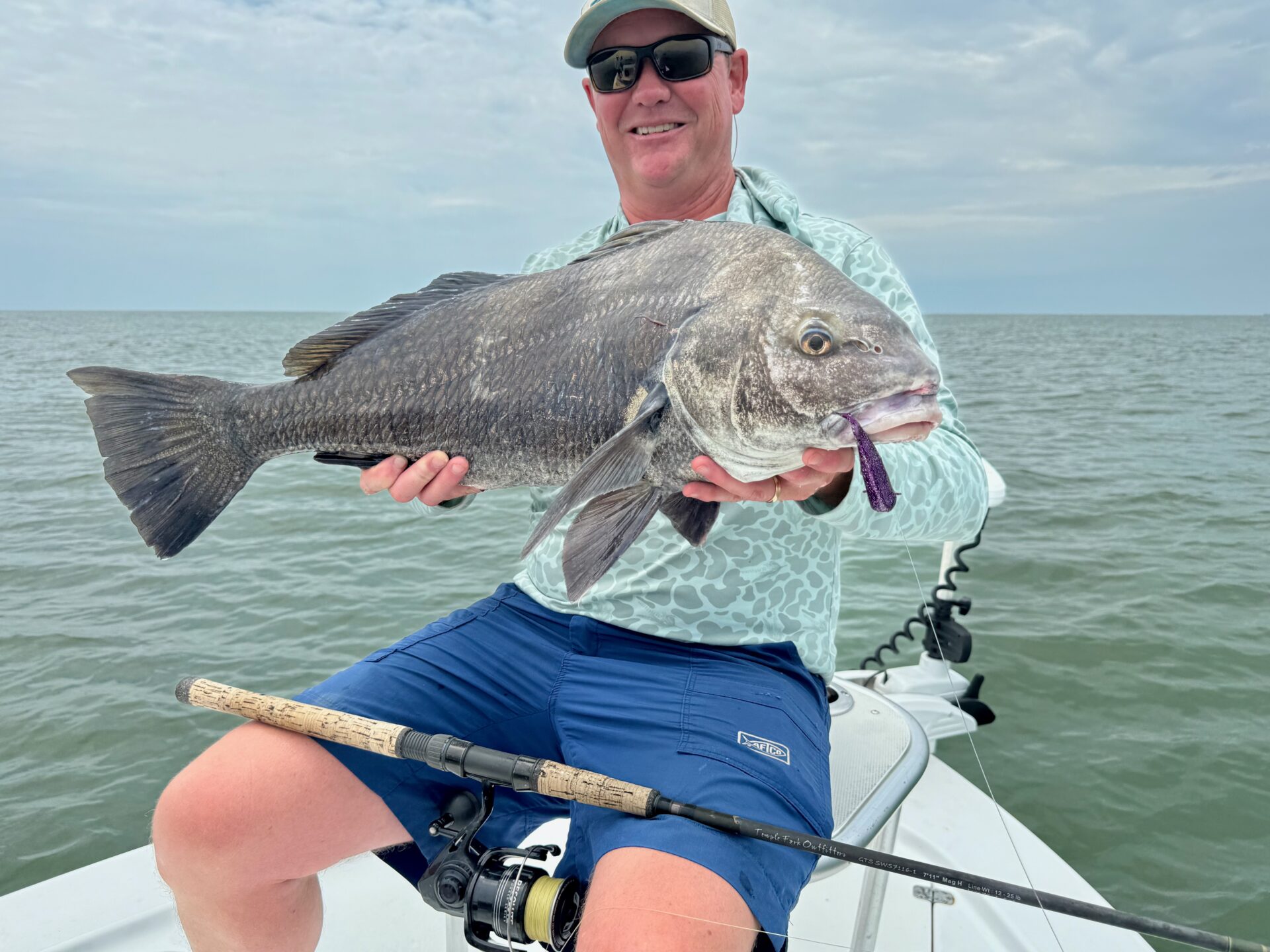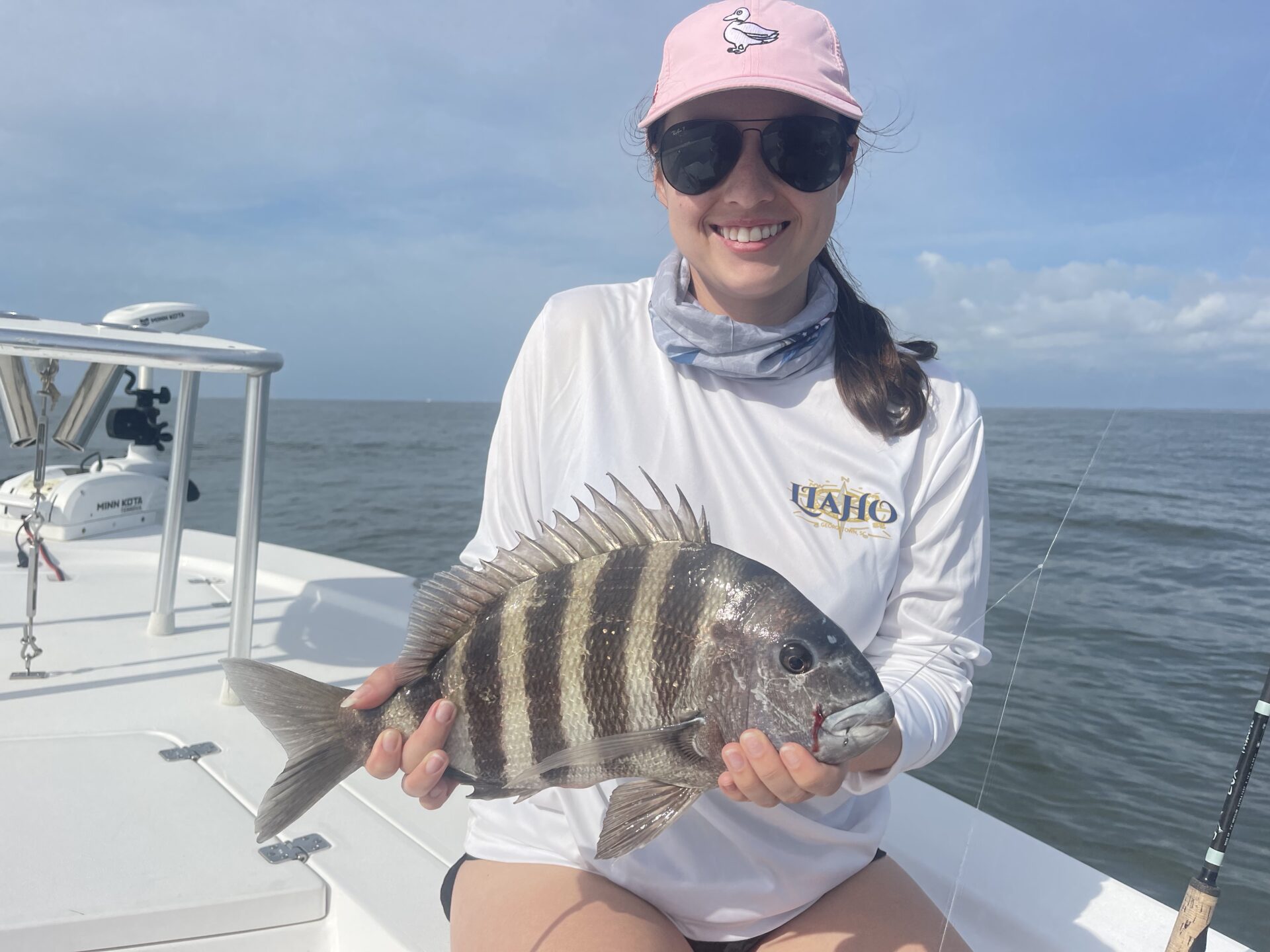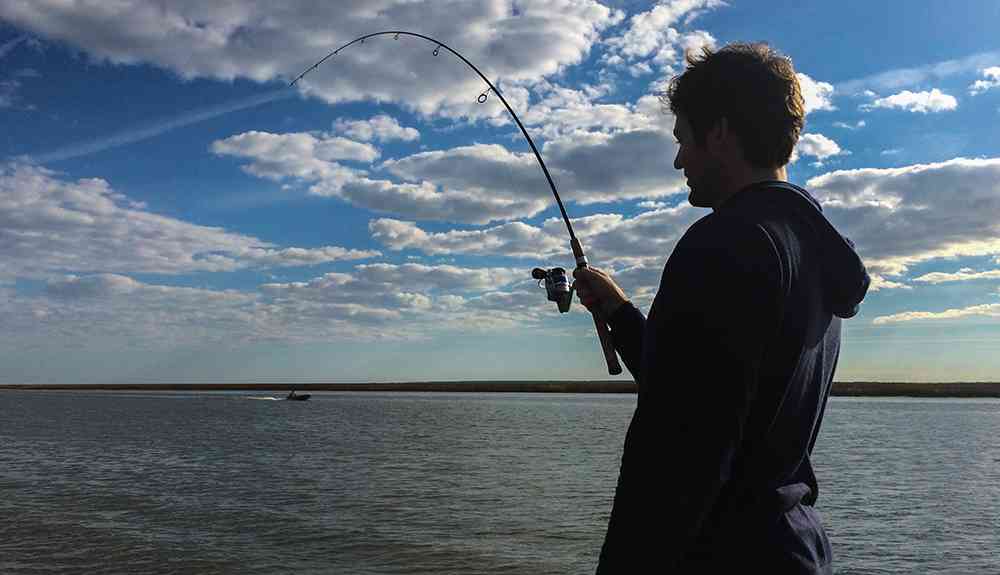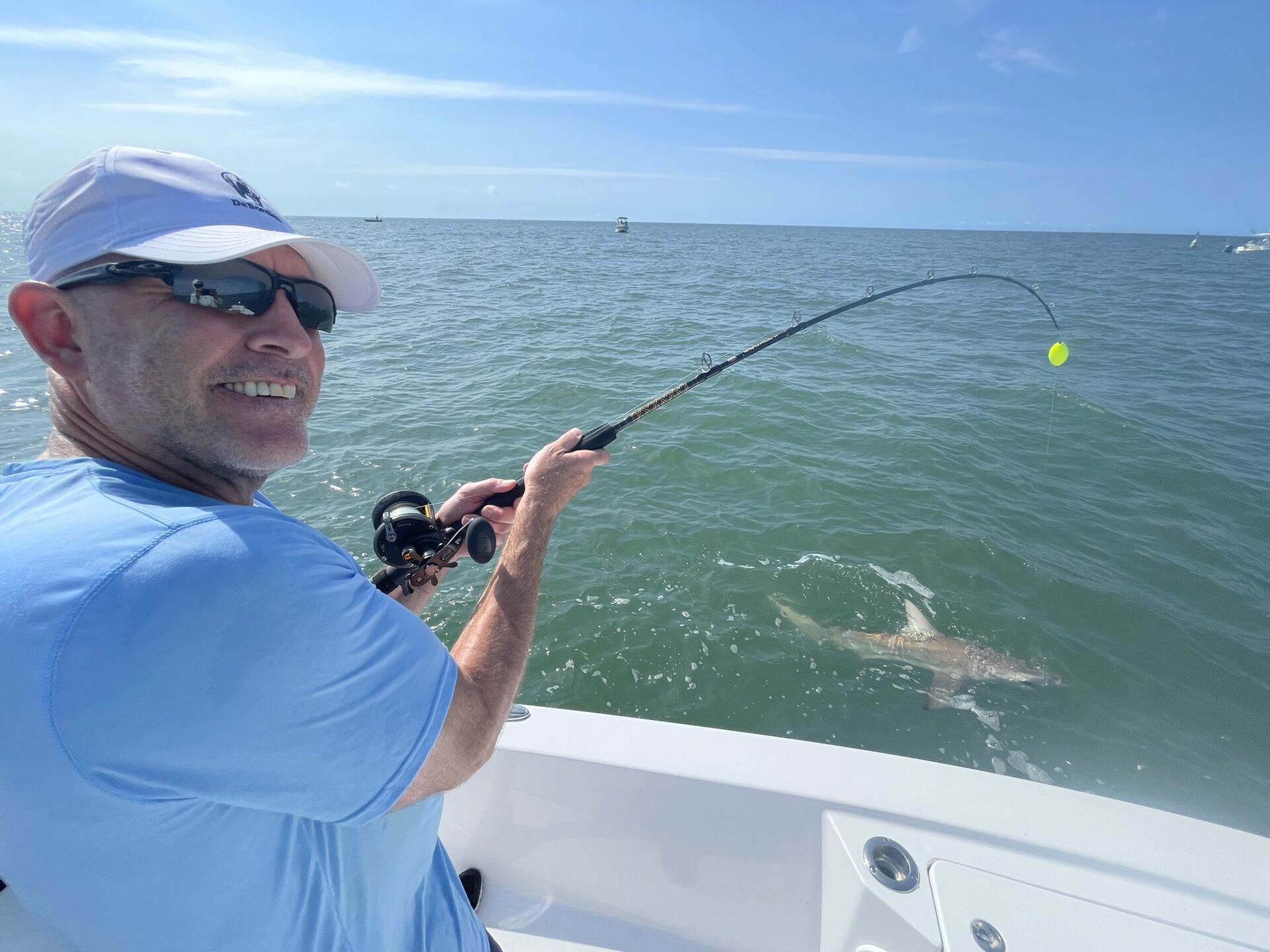Last Updated on March 19, 2025 by Eric Bonneman
The inshore waters off South Carolina shift dramatically in late spring and early summer as warming temperatures bring seasonal migrations, shifts in feeding behavior, and changes in where fish are found. For fishermen, this means some of the best action of the year, with opportunities to catch a wide variety of species in tidal creeks, estuaries, inlets, and nearshore waters.
While some fish, like red drum and spotted seatrout, are the main targets for inshore fishermen, plenty of others make their presence known, from the aggressive Spanish mackerel to the hard-fighting jack crevalle. Sharks are a common bycatch, with blacktip and bonnethead sharks frequently hooked while targeting other species. Bottom-dwellers like sheepshead and black drum offer a challenge near structure, and baitfish like blue runner and ladyfish provide fast action even if they aren’t the primary goal. Some species, such as cobia or tarpon, are rare but highly prized when encountered.
Understanding which fish are most likely to be found inshore this time of year, how they behave, and what to expect when they take the bait can make all the difference. This guide provides a comprehensive look at the many species fishermen may encounter, covering their habitats, feeding behaviors, fight characteristics, and how they’re typically caught. Whether targeting a specific fish or simply casting into the unknown, being prepared for what’s in these waters ensures a better experience and a greater chance of success.
Primary Gamefish
Black Drum
Black drum are a common and highly targeted species in South Carolina’s inshore waters. These fish are recognizable by their heavy, thick body, large rounded head, and strong tail. Juveniles have dark vertical bars across their bodies, while adults develop a more uniform grayish-black color.
Black drum are typically found near oyster beds, docks, bridges, and deeper inshore channels. Juveniles tend to stay in shallower waters, while the larger adults prefer deeper environments. They primarily feed on crabs, shrimp, and mollusks, using their powerful jaws to crush shells.
These fish are often caught using live or dead shrimp, crabs, or cut bait near structures. Once hooked, black drum put up a strong, steady pull, but they rarely jump. Due to their weight, they can be difficult to reel in, especially larger fish. While there are no major handling hazards, larger black drum are heavy and strong, requiring proper support when handling. They are a highly sought-after species due to their size and fight, making them a staple for inshore fishermen.

Red Drum (Redfish)
Red drum, also known as redfish, are one of the most commonly caught inshore gamefish. They are recognized for their bronze-to-reddish body and distinctive black spot (or multiple spots) near the tail, which is a defining characteristic of this species.
Juvenile red drum, often referred to as “puppy drum,” stay inshore year-round, while the larger adults tend to migrate offshore during the winter months. These fish are often found in estuaries, tidal creeks, and near oyster beds. They feed on crabs, shrimp, mullet, and small baitfish, often hunting aggressively in shallow waters.
Red drum are commonly caught using live shrimp, mullet, crabs, cut bait, or artificial lures. When hooked, they exhibit a strong, steady pull, often making long runs and occasional surface thrashes. The fight is consistent, with the fish attempting to escape into structure. Handling large red drum requires care as their size can make them difficult to manage. They are one of the most prized inshore gamefish due to their abundance and fighting ability.
Spotted Seatrout (Speckled Trout)
Spotted seatrout, also known as speckled trout, are another popular and highly targeted gamefish in South Carolina’s inshore waters. These fish are identified by their sleek, elongated body and silver color with dark spots across their back and sides.
Speckled trout are often found in grass flats, estuaries, tidal creeks, and near oyster beds, where they feed primarily on shrimp, mullet, and small baitfish. They are ambush predators, often waiting in cover to strike their prey. These fish are known for their quick, aggressive strikes when hunting, making them a highly sought-after catch.
To target speckled trout, fishermen often use live shrimp, soft plastics, topwater lures, or jigs. When hooked, they provide a strong fight, often making quick runs and head shakes. While they do not put up the longest battles, their abundance and aggressive feeding behavior make them a favorite species for inshore fishermen.
Sheepshead
Sheepshead are easily recognized by their deep body and vertical black stripes that run across their silver-gray coloring. They are known for their human-like teeth, which they use to crush barnacles and other shellfish.
These fish are typically found near docks, bridges, oyster beds, and jetties, where they feed on crabs, shrimp, and barnacles. They are somewhat difficult to hook due to their tendency to nibble at the bait before biting down hard. Fiddler crabs, shrimp, and sand fleas are the most commonly used baits to target sheepshead.
Once hooked, sheepshead put up a strong fight with deep, deliberate pulls, often diving toward structure. They are a tough fish to manage due to their tendency to retreat into cover, and caution should be taken when handling their sharp dorsal spines. Despite these challenges, sheepshead are a prized catch due to their fight and their taste.

Spanish Mackerel
Spanish mackerel are fast-moving fish that travel in schools, hunting aggressively for smaller baitfish and shrimp. They have a sleek, torpedo-shaped body with a greenish-blue back and silver belly, as well as distinctive rows of yellow spots along their sides.
These fish are often found near estuaries, inlets, and nearshore waters during late spring and early summer, where they feed on smaller fish and shrimp. They are often targeted using spoons, jigs, or live bait.
When hooked, Spanish mackerel fight with quick bursts of speed and erratic movements, often jumping and darting through the water. Their sharp teeth require careful handling when unhooking them. Despite their smaller size compared to other gamefish, Spanish mackerel are highly prized for their speed and challenging fight.
Other Species People Are Likely to Target
Cobia
Cobia are large, powerful fish that occasionally venture into estuaries and nearshore waters. They are typically found around rays or sharks and are known for their aggressive feeding behavior. Cobia have a dark brown back, white belly, and broad, flat head.
These fish primarily feed on crabs, squid, and small fish. When targeting them, live bait (such as eels and pinfish), jigs, or topwater lures are commonly used. When hooked, cobia put up a powerful fight, often diving deep and making long runs. They are a rare catch inshore but are highly prized by fishermen for their size and strength.
Tarpon
Tarpon are large, silver fish known for their impressive size and acrobatic jumps. They are usually found in estuaries, tidal rivers, and near inlets, particularly during the warmer months of late spring and early summer. Tarpon can grow to over 150 pounds, making them a challenging and exciting catch.
These fish feed on mullet, menhaden, and shrimp, often seen rolling at the surface. They are particularly prized for their spectacular fight when hooked, characterized by high, acrobatic jumps and powerful runs. Live bait (such as mullet or pinfish) is commonly used, along with large artificial lures. While tarpon are highly sought after, they are rarely caught inshore due to their tendency to stay in deeper waters. However, for those who do encounter one, tarpon offer an unforgettable challenge.
Crevalle Jack
Crevalle jack are thick-bodied fish with a yellowish tint and a dark spot on their gill plate. These fish travel in large schools and are known for their aggressive feeding behavior, chasing down baitfish, shrimp, and crabs.
Found in estuaries, inlets, and near bridges, they provide a strong, energetic fight when hooked. They are commonly caught on topwater lures, jigs, or live bait. Once hooked, they put up a strong fight, with bulldogging runs that can tire a fisherman. While not often eaten due to their strong taste, they are a popular target for sport due to their strength and aggressive behavior.

Bluefish
Bluefish are highly aggressive, fast-moving predators that feed on menhaden, mullet, and other baitfish. These fish have a sleek, torpedo-shaped body with a greenish-blue back and silver belly. They are typically found in estuaries, inlets, and near beaches, often schooling while chasing down bait.
Bluefish are commonly caught on spoons, topwater plugs, or cut bait. Once hooked, they fight aggressively, often making sudden runs and jumps out of the water. Their sharp teeth require caution when handling them, and while they are sometimes bycatch for those fishing for red drum or trout, they are also targeted for their speed and fighting ability.
Pompano
Pompano are small, deep-bodied fish with a silvery body and a slightly yellowish tint on their fins and belly. These fish are commonly found in sandy flats, surf zones, and near inlets, often in schools. Pompano feed on small crustaceans, sand fleas, and shrimp.
Fishermen targeting pompano often use shrimp, sand fleas, or small jigs. They put up a fast, darting fight, often making sudden bursts of speed. Pompano are highly prized for their taste and are a targeted species when present inshore.
Lane Snapper
Lane snapper are usually found offshore, but juveniles sometimes venture into estuaries and nearshore reefs. These pinkish-red fish have yellowish horizontal stripes and a black spot near the dorsal fin. They feed on small fish, shrimp, and crabs, typically bottom-feeding near structures.
While not common inshore, lane snapper are sometimes caught when bottom fishing with shrimp or squid. They provide a strong fight relative to their size, with quick darting movements. Lane snapper are a prized food fish when present but are rare in inshore waters.
Weakfish
Weakfish are sleek, silver fish with a yellowish tint on their fins and faint spots along their back. They are typically found in estuaries, tidal creeks, and near sandbars, preferring slightly deeper waters than spotted seatrout. Weakfish feed on shrimp, small fish, and squid, ambushing their prey from below.
They can be caught using jigs, shrimp, or live bait. Weakfish put up a moderate fight with strong head shakes but tire relatively quickly. They are not as common as some other species but are still targeted when present due to their size and the challenge they present.
Blacktip Shark
Blacktip sharks are often found in deeper inshore waters, near estuary mouths, and sandbars. Known for their aggressive behavior and strength, these sharks are a popular target for fishermen, especially those using live or cut bait.
Once hooked, blacktip sharks put up a fast, strong fight, often jumping out of the water in attempts to shake the hook. They require caution when handling due to their sharp teeth, but their size and fighting ability make them a favored species for many anglers.

Bonnethead Shark
Bonnethead sharks are smaller compared to other sharks but still provide an exciting fight. These sharks are typically found in shallow sandbars, flats, and estuaries, often in areas with seagrass. Bonnethead sharks feed primarily on crabs, shrimp, and small fish.
They put up a steady pull when hooked, but do not make long runs. Though typically caught as bycatch, some fishermen target them for sport, as they provide an enjoyable challenge. Their small but sharp teeth require careful handling.
Gag Grouper
Gag grouper are typically found offshore, but juvenile gag grouper sometimes enter estuaries and nearshore reefs. These fish are known for their dark brown blotches and their large mouths, which they use to ambush prey like fish, squid, and crustaceans.
Though not commonly caught inshore, gag grouper are highly prized by anglers and are sometimes caught using live bait or cut bait near structure. When hooked, they make a powerful initial run, often trying to retreat into structure, making them challenging to reel in.
Mangrove Snapper (Gray Snapper)
Mangrove snapper are commonly found near docks, piers, jetties, and mangrove areas. These fish feed on small fish, shrimp, and crabs. They are quick feeders, often striking immediately when bait is presented.
Mangrove snapper are frequently targeted using live shrimp, cut bait, or small jigs near structure. When hooked, they put up a quick, strong initial run, trying to retreat into the structure. They are a highly sought-after species for both food and sport.
Blue Runner
Blue runners are found near bridges, inlets, and deep channels. These streamlined fish have a metallic blue-green back and silvery-white sides. They are often caught while using live bait, spoons, or jigs near moving water.
Though not often a primary target, blue runners fight with strong runs and are known for their fast bursts of energy, making them an exciting catch. They also make great bait for larger predatory species like cobia and kingfish.
Sand Seatrout (White Trout)
Sand seatrout are found in estuaries, tidal creeks, and near inlets, preferring sandy and muddy bottoms. They feed on shrimp, small fish, and crabs. Sand seatrout are often targeted for their abundance and easy catch.
They can be caught using live shrimp, cut bait, or small jigs. Sand seatrout provide a moderate fight with head shakes, and they tire relatively quickly. They are often targeted for food and are a favorite for fishermen seeking a consistent catch.

Common Bycatch
-
Hardhead Catfish: Found in shallow bays, estuaries, and surf zones. They feed on shrimp, dead fish, and detritus. They put up a slow, steady pull when hooked and have sharp, venomous spines on their dorsal and pectoral fins.
-
Ladyfish: Slender, silvery fish with large eyes and a deeply forked tail. Found in estuaries, inlets, and shallow bays. They feed on small fish, shrimp, and squid. Known for their fast, erratic fight with high jumps and tail-walking.
-
Needlefish: Long, slender fish with sharp teeth and a greenish-blue back. Found near the surface of estuaries, tidal creeks, and nearshore waters. They feed on small fish and shrimp and can be erratic, thrashing and leaping when hooked.
-
Sharpnose Shark: Slender sharks found in shallow bays, estuaries, and sandbars. Active predators, they feed on small fish, squid, and shrimp. They make fast, erratic runs and sometimes jump when hooked. Sharp teeth require careful handling.
-
Southern Kingcroaker (Whiting): Bottom-feeding fish found in shallow bays, tidal creeks, and estuaries. They feed on small shrimp, crabs, and marine worms. When hooked, they put up a moderate fight with short bursts of energy.
-
Spadefish: Found near wrecks, jetties, pilings, and buoys. They feed on jellyfish, small invertebrates, and plankton. They put up a strong fight with deep resistance and are sometimes targeted for sport, though they are generally considered bycatch.
-
White Bass: Stout, silver fish with dark horizontal stripes. Found in brackish estuaries, tidal rivers, and inlets. They feed on shad, minnows, and small crustaceans, providing a strong fight with rapid head shakes and deep runs when hooked.
Make the Most of Inshore Fishing This Season
Late spring and early summer bring some of the best fishing opportunities off South Carolina’s coast, with a wide variety of species in their prime. From red drum and spotted seatrout to Spanish mackerel and jack crevalle, the action in the inshore waters is steady and exciting.
While targeting species like red drum and speckled trout is common, fishermen will also encounter a range of bycatch species, including blacktip sharks, bonnethead sharks, and sheepshead. These fish provide strong fights, adding to the overall thrill of fishing in these waters.
Understanding where these fish are, how they feed, and what to expect when they strike will ensure that you’re ready for anything. Whether you’re focused on a specific target or just casting to see what bites, this time of year offers plenty of chances for success.
For a guided experience that puts you right where the action is, book a trip with us at Carolina Guide Service. Our experienced team will get you on the water and maximize your chances of a memorable day fishing the inshore waters of South Carolina. Don’t miss out – book your trip today!
